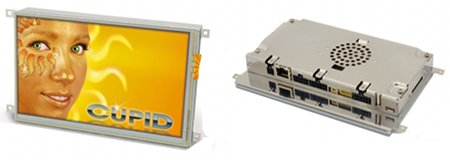HMI panel has capacitive option
Feb 22, 2010 — by LinuxDevices Staff — from the LinuxDevices Archive — 23 viewsGarz and Fricke GmbH announced a seven-inch panel PC that's available with either resistive or capacitive touchscreens. The Linux-compatible “Cupid 7.0” incorporates a 532MHz Freescale i.MX35 CPU, can be powered via Ethernet, offers CANbus and multiple serial ports, and includes a stainless-steel housing, the company says.
 Garz and Fricke says its new Cupid 7.0 is intended primarily for HMI (human machine interface) and industrial control use, but may also be employed in laboratory, point-of-sale, and automotive applications. The device is said to be available with either resistive or projected capacitive touchscreens, and with or without the aluminum front bezel shown at right. Both the standard and "open-frame" versions feature a stainless-steel housing, the Hamburg-based company adds.
Garz and Fricke says its new Cupid 7.0 is intended primarily for HMI (human machine interface) and industrial control use, but may also be employed in laboratory, point-of-sale, and automotive applications. The device is said to be available with either resistive or projected capacitive touchscreens, and with or without the aluminum front bezel shown at right. Both the standard and "open-frame" versions feature a stainless-steel housing, the Hamburg-based company adds.

The open-frame version of the Cupid 7.0
The Cupid 7.0 is built around the 532MHz Freescale i.MX35, a processor that was introduced in 2008 and is generally associated with automotive applications. (Freescale broadened its market last year with the related i.MX353 and i.MX357, again based on ARM 1136JF-S cores.) According to Garz and Fricke, the panel PC has 128MB of DDR memory, 256MB of NAND flash storage, and an SD expansion slot.
Garz and Fricke says the Cupid's touchscreen offers a resolution of 800 x 480 pixels and a 400-nit brightness rating. The device has an internal speaker, plus a connector for an external speaker, the company adds.

Ports on the bottom of the Cupid 7.0
(Click to enlarge)
The bottom of the Cupid has a multitude of ports, but as the image above shows, some of these do not use standard PC-style connectors. For example, the panel PC's RS232, power, digital I/O, CANbus/RS485, and RS232 ports employ Molex Micro-Fit 3.0 connectors, the company says. However, the device has more traditional connectors for its USB host, USB On-the-Go, and Ethernet ports.
Speaking of the latter, the Cupid can run via PoE (power over Ethernet) or from a 12/24VDC power source, Garz and Fricke says. An external 8 x 8 keypad may be connected to the panel PC's SPI/keypad interface, while safety can be increased (and ground loops avoided) by optional galvanic isolation of the CAN/RS485 port, the company adds.
According to Garz and Fricke, the Cupid 7.0 runs Linux or Windows CE. Preinstalled ROM images plus optimized driver and support packages are available, ensuring fast time-to-market, says the company.
Specifications listed by Garz and Fricke for the Cupid 7.0 include:
- Processor — Freescale i.MX35 clocked at 532MHz
- Memory — 128MB of DDR2 RAM and 256MB of NAND flash storage
- Display — 7-inch touchscreen display with 800 x 480 pixel resolution and 400-nit brightness rating; available in resistive or capacitive versions
- Expansion — SD slot
- Networking — 10/100 Ethernet with PoE support
- Other I/O:
- Audio out (powered 1 Watt mono amp)
- 2 x RS232
- 1 x RS485
- 1 x CANbus
- 1 x USB 2.0 host
- 1 x USB On-the-Go
- Digital I/O (2 in, 2 out)
- SPI/keypad
- Power — 12/12VDC or PoE; consumption n/s
- Operating range — -4 to 158 deg. F (-20 to 70 deg. C)
- Dimensions, with front bezel — 7.95 x 4.96 x 1.16 inches (202 x 126 x 29.5mm)
- Weight — 1.25 pounds (570g)
Availability
Garz and Fricke said the Cupid 7.0 will be demonstrated early next month at the Embedded World 2010 conference in Nuremberg, and available later in March. Pricing was not disclosed.
More information on the Cupid 7.0 may be found on the Garz and Fricke website, here.
This article was originally published on LinuxDevices.com and has been donated to the open source community by QuinStreet Inc. Please visit LinuxToday.com for up-to-date news and articles about Linux and open source.